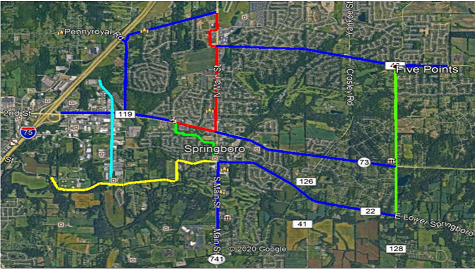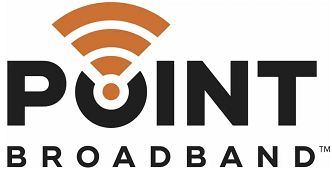After years of fielding complaints from residents about the speed, reliability, and poor customer service of the city’s single wireline broadband provider, Springboro, Ohio (pop. 19,000) has decided enough is enough. Over the next year, the city (situated ten miles south of Dayton) will build a 23-mile fiber loop for municipal services and, at the same time, lay five additional conduits to entice additional Internet Service Providers (ISPs) to come in and offer service, stimulating competition and economic development in the region moving forward.
A Fiber Master Plan
City Manager Chris Pozzuto laid out the plan for the city council, which staff had been working on for the last half year, back in July. It was driven in part by the criticism his office had fielded for years about the incumbent wireline service provider (the two satellite providers also prompted plenty of complaints of their own). As far as the city was concerned, CenturyLink’s gigabit tiers often didn’t provide advertised speed, and the tier also offered extremely limited upload speeds. Out of a desire both to provide residents with symmetrical gigabit access and stimulate economic development on a 200-acre commercial plot, Pozzuto started talking with regional partners and putting together an alternative.
The city’s Fiber Master Plan [pdf] calls for a 72-strand, 23-mile loop to be built around Springboro, along every major street and thoroughfare and up to the entrance of every neighborhood. Via microtrenching, six conduits will be laid — one for the city, and the remaining for up to five new ISPs to compete for service.

The city will contract with the Miami Valley Education Computer Association (MVECA) to build the network, lay the additional conduit, and provide access back to the peering point to the northeast in Columbus. A second line will come in from the south via the Southwest Ohio Computer Association (SWOCA) to provide redundancy.
Construction is projected to be complete within a year, and expected to cost around $2.5 million. The Warren County Port Authority will own the network and lease it to Springboro until the debt is repaid, at which point the city will own the network.
Recouping Costs
Once the project is done, interested ISPs will be free to install as much capacity as they like, but part of the deal requires new entrants to dedicate four strands to the city for municipal use. Should all five conduits fill up, it means 20 additional strands for Springboro. It’s worth noting, too, that providers will be responsible for extending infrastructure from the entrypoint of each neighborhood up to homes and businesses. While this dramatically lowers construction costs for the city, it raises the capital costs for providers who want to extended their service footoprint, and the city manager admitted to the council that it could mean neighborhoods get service from different ISPs. Theoretically, it could also lead to cherrypicking those neighborhoods that offer the most return on investment, leaving poorer parts of the city unconnected (or lagging behind).
Pozzuto’s office projects that the first ISP making use of the conduit will generate around $100,000 in revenue each year. The city will charge thirty-eight cents per linear foot to lease the conduit, which will bring in approximately $48,000. In addition, ISPs will pay $700/month to lease space in a city building termination point for rack space, power, and the backhaul connection. And finally, each subscriber will pay a usage fee to their provider which will be passed on to the city to help it repay the loan, ranging from $2 at the 25 Mbps (Megabits per second) tier to $4/month at the gigabit tier. Those outside of city limits but living in the township won’t be left behind, but will pay usage fees fifty percent higher since the city is paying for construction. The city expects to pay off the investment in three years.

Springboro has announced that Point Broadband will be first in the door. During the course of planning, local telecommunications provider Intelliwave Broadband was an original partner, but in searching for ways to raise the capital needed for the project they met Point Broadband, which decided to buy them outright and provide service itself. Point Broadband offers broadband and VoIP services in Alabama, Georgia, Louisiana, Maryland, Mississippi, Ohio, Tennessee, and Virginia. In Ohio the company currently serves Amanda, Commercial Point, and areas in the south central part of the state. In some places it operates a fixed wireless network. A subsidiary of ITC Capital (out of West Point, GA), it was founded in 2017 and has roughly 50,000 subscribers.
Pozzuto emphasized taking a long view to the city council back in July:
While revenue is important . . . this fiber plan [is] more of a community development project. While we always want to recoup the expense, we build roads, we resurface roads, but we do not always get a direct benefit back from those projects . . . Residents will see a direct benefit from this project by allowing them to use these channels to get [Internet access].
Prices at this point are unknown. In nearby Amanda, Ohio, Point Broadband offers symmetrical service tiers at 100 Mbps, 200 Mbps, 500 Mbps, and 1 Gbps for $80/month, $90/month, $110/month, and $130/month respectively.
The Springboro Approach
Springboro’s model represents something of a middle ground, with the city firmly committing to fiber infrastructure for its own services but also leveraging that investment to build the conduit that will attract additional providers to town. Pozzuto told the city council in the July meeting that, ideally, they would see three providers come in to offer service.
At the same time, we’ve seen municipalities like West Des Moines, Iowa, take things a step further and lay conduit to every single home and business in the city, lowering the barrier to entry. Dublin, Ohio, has shown the multitude of benefits that can come from not only city-owned conduit, but a fiber network that caters to city businesses while leasing dark fiber at the time.
Springboro’s plan aims for improvement to economic growth and high-impact jobs in the area, as well as support for health care services, education, aging care, energy and other smart city initiatives, and other e-services by the local government and more participation.
Correction: this story originally named CenturyLink as the wireline service provider which prompted resident complaints, but this was not the case.
Header image from Wikimedia Commons user Ed! used in according with Creative Commons Attribution-Share Alike 3.0
This article was originally published on ILSR’s MuniNetworks.org. Read the original here.





